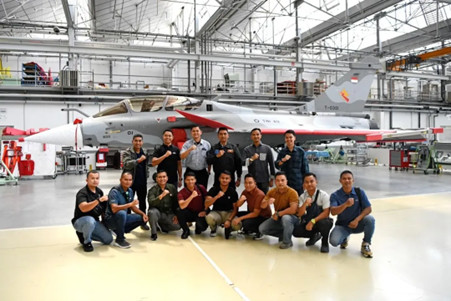Popular Reads
Top Results
Can't find what you're looking for?
View all search resultsPopular Reads
Top Results
Can't find what you're looking for?
View all search resultsThe hefty price of low-cost defense systems
While cost-effectiveness and price tags are essential indicators, the procurement of arms must always include performance, strategic effect and sustainability as key metrics when assessing new equipment or platforms.
Change text size
Gift Premium Articles
to Anyone
 The Indonesian Air Force' pilots and technicians pose in front of Indonesia's first Dassault Rafale B jet fighter at the Dassault production line in Merignac, near Bordeaux, France, in this undated picture released on Aug. 11. As many as four pilots and 12 technicians are taking courses in France on how to operate and maintain Rafale jet fighters. (Courtesy of Indonesian Air Force/-)
The Indonesian Air Force' pilots and technicians pose in front of Indonesia's first Dassault Rafale B jet fighter at the Dassault production line in Merignac, near Bordeaux, France, in this undated picture released on Aug. 11. As many as four pilots and 12 technicians are taking courses in France on how to operate and maintain Rafale jet fighters. (Courtesy of Indonesian Air Force/-)
T
he world has seen headlines dominated by images of low-end, low-cost unmanned air vehicles (UAVs) and small drones. These devices are disrupting maritime shipping in the Red Sea and assisting Ukrainian troops in stalling Russia's advance on the battlefield.
This evolution of warfare gives the impression that deterring adversaries or winning a conflict can be achieved with low-cost military and defense equipment. It is understandable that many countries, including Indonesia, are drawn to considering cheaper defense systems as a way to stretch limited budgets and manage funding constraints.
While this approach might be effective for expendable items like drones and loitering munitions, it often conceals higher risks when it comes to the performance requirements of major defense systems.
The primary rationale behind acquiring low-cost defense systems is the promise of significant savings. Some might even argue that it allows for a focus on quantity, providing more assets for a similar budget allocation.
However, the reality on the ground is often different. While this pattern works for expendable equipment like UAVs, it does not hold true for major defense platforms. In fact, for these larger systems, the seemingly "cheaper" choice frequently proves to be the costlier one due to a higher lifecycle cost.
Over time, and often in the short to mid-term, each hour of use can carry a much higher price tag than expected. This translates into more frequent maintenance operations and a shorter operational life, ultimately leading to early retirement.
Another significant issue is the operational performance gap. Lower-tier platforms and systems often lack the endurance, precision or survivability of their high-end counterparts. This difference in price is explained by years, and more often decades, of essential Research and Development (R&D), which includes prototyping and extensive field testing before production begins.


















